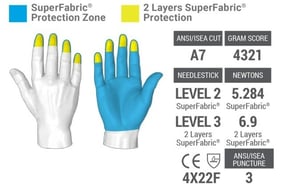
Needle-Resistant Protection
It is no secret that law enforcement officers are among many professions that face dangerous situations during their time on the clock - but they are also faced with an overlooked threat: needlesticks.
A needlestick injury poses an elevated danger due to the risk of infection from bloodborne pathogens (diseases) such as hepatitis B and C, and HIV. These diseases can be extremely dangerous to your health, as well as financially costly - and potentially even life-threatening. With nearly 47,000 deaths, drug addiction and the opioid crisis have caused substance use disorders in another 1.7 million people in the US in 2017 alone. 60-80% of injection drug users have an infectious bloodborne pathogen - which means first responders, firefighters, public safety officials, and correctional officers are highly vulnerable to needlestick threads and the risks that come with them.
This risk most commonly occurs during pat-down searches, property searches, searches incident to arrest, and vehicle searches. So what is the best way to avoid an unexpected needlestick injury while on the job? Needlestick-resistant gloves.
Needlestick-resistant gloves offer the ability to lower the odds of a needlestick injury in law enforcement. A 2017 report, published by the U.S. Department of Health and Human Services, recommends "providing officers with [needle- and] cut-resistant gloves for their use when they are performing searches and pat-downs," in addition to providing them with nitrile gloves and/or face shields.
In order to be safe from the dangers of accidental needlestick injuries, choosing an effective and reliable needle-resistant glove needs to be of first priority for law enforcement. Let's look at 3 tips to help you choose the right glove for you:
1. Understand what makes a glove needlestick-resistant
There are a lot of products that use terms like "puncture-resistant" and "slash-resistant" but they don't substantiate these claims with test results. Therefore, make sure you are aware and look for a detailed product explanation from the manufacturer regarding needlestick testing or test scores - needlestick testing is imperative to ensure the gloves are truly needle resistant. Under the ANSI/ISEA 105 hand protection standard, ASTM F2878 addresses the unique mechanics of hypodermic needle punctures related to PPE and is performed using a 25-gauge needle. Ratings are scored on a 1-5 scale, with a level 5 measuring at 10 Newtons or higher.
2. Needle resistance stands alone as a protective feature
Needle resistance is much different from industrial [blunt] puncture. Industrial or blunt puncture testing uses a probe to stimulate a tear or burst hazard, whereas needlestick puncture testing utilizes a 21-, 25-, or 28- gauge hypodermic needle to more accurately account for needle hazards in work environments. When it comes to cut protection, testing for this standard is much different than puncture, and the material used does not always provide needle-resistance. Make sure your glove is not just puncture or cut resistant - but is actually "needle-resistant" and that it has been tested in accordance with ASTM F2878 under ANSI/ISEA 105.
3. Identify the protection zones with needle-stick gloves
There are four different protection zones:
- Your fingertips: often one of the first parts of your hand that could come in contact with a needlestick
- Sides of your fingers: can be vulnerable in a glove when needle-stick hazards are present
- Your palm: the most injured part of the hand, so you'll want most protection from needle, cut, and puncture here
- Back of your hand: depending on your task, you'll want the back of your hand protected from needlestick and cut hazards alike
HexArmor PointGuard Ultra has the highest needlestick resistance available with the help of SuperFabric brand material. Why is this glove ideal for law enforcement officers?
- Highest level of needlestick resistance AND cut resistance
- Neoprene cuff with Velcro closure for secure fit
- Back-of-hand knuckle padding for incidental bumps and impacts
- Silicone palm pattern for enhanced durability and grip
- Form-fitting design for increased dexterity and comfort
- Launderable
Just one prick from a used needle can change someone's life. It is vital that law enforcement officers and even those that work in the environmental cleanup industry, feel safe when on the job.
Since you keep us safe daily, let us keep you safe always.
Want to know more about National Police Week?
- Visit nleomf.org
- Talk To A Ritz Safety Expert

